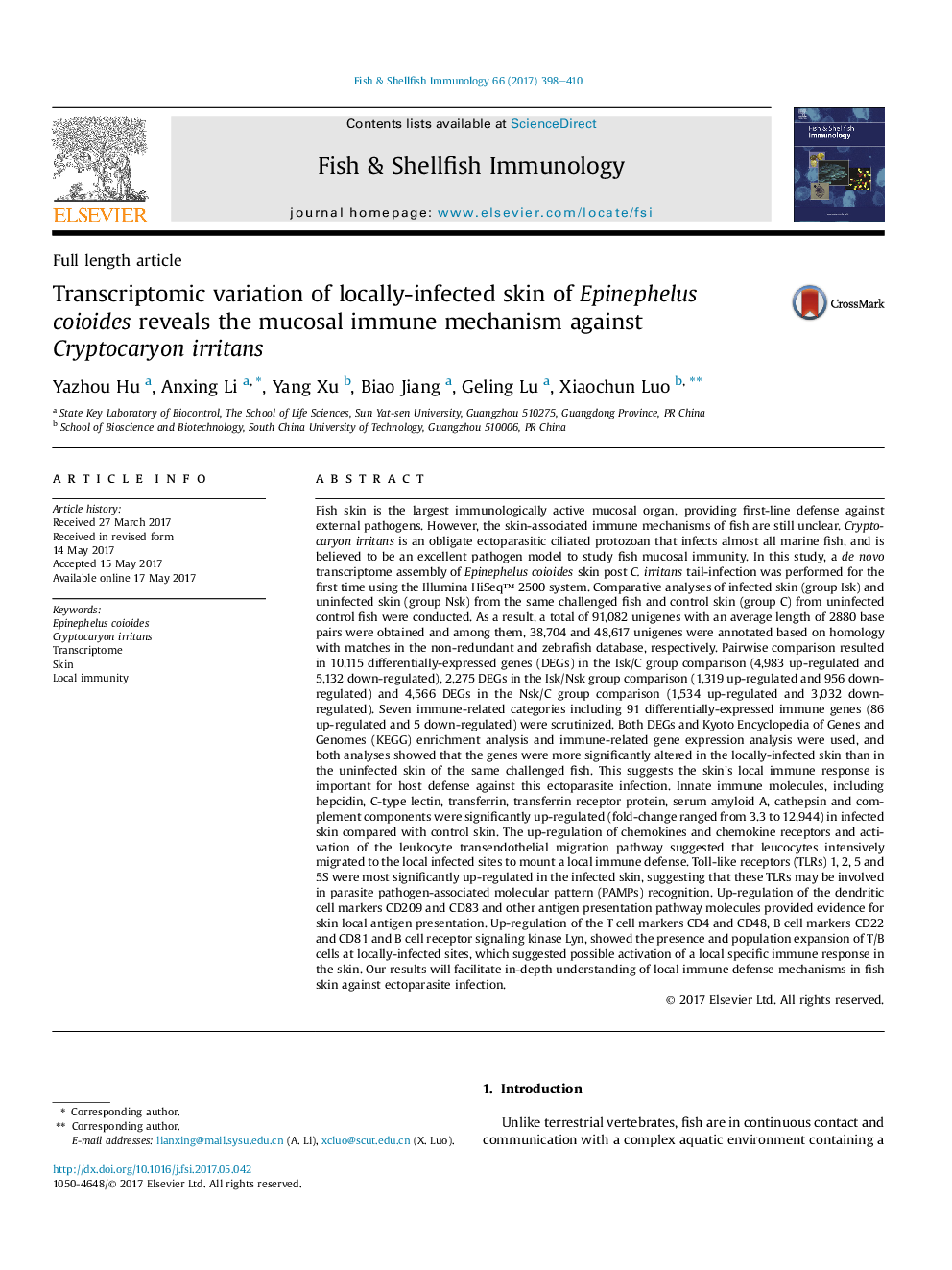| Article ID | Journal | Published Year | Pages | File Type |
|---|---|---|---|---|
| 5540741 | Fish & Shellfish Immunology | 2017 | 13 Pages |
â¢We firstly explored Epinephelus coioides skin immune response following local exposure to Cryptocaryon irritans by RNA-Seq.â¢91082 unigenes with an average length of 2880 base pairs were obtained.â¢DEGs were more significantly altered in the locally-infected skin than in the uninfected skin of the same challenged fish.â¢Multiple immune-related pathways were significantly regulated.
Fish skin is the largest immunologically active mucosal organ, providing first-line defense against external pathogens. However, the skin-associated immune mechanisms of fish are still unclear. Cryptocaryon irritans is an obligate ectoparasitic ciliated protozoan that infects almost all marine fish, and is believed to be an excellent pathogen model to study fish mucosal immunity. In this study, a de novo transcriptome assembly of Epinephelus coioides skin post C. irritans tail-infection was performed for the first time using the Illumina HiSeq⢠2500 system. Comparative analyses of infected skin (group Isk) and uninfected skin (group Nsk) from the same challenged fish and control skin (group C) from uninfected control fish were conducted. As a result, a total of 91,082 unigenes with an average length of 2880 base pairs were obtained and among them, 38,704 and 48,617 unigenes were annotated based on homology with matches in the non-redundant and zebrafish database, respectively. Pairwise comparison resulted in 10,115 differentially-expressed genes (DEGs) in the Isk/C group comparison (4,983 up-regulated and 5,132 down-regulated), 2,275 DEGs in the Isk/Nsk group comparison (1,319 up-regulated and 956 down-regulated) and 4,566 DEGs in the Nsk/C group comparison (1,534 up-regulated and 3,032 down-regulated). Seven immune-related categories including 91 differentially-expressed immune genes (86 up-regulated and 5 down-regulated) were scrutinized. Both DEGs and Kyoto Encyclopedia of Genes and Genomes (KEGG) enrichment analysis and immune-related gene expression analysis were used, and both analyses showed that the genes were more significantly altered in the locally-infected skin than in the uninfected skin of the same challenged fish. This suggests the skin's local immune response is important for host defense against this ectoparasite infection. Innate immune molecules, including hepcidin, C-type lectin, transferrin, transferrin receptor protein, serum amyloid A, cathepsin and complement components were significantly up-regulated (fold-change ranged from 3.3 to 12,944) in infected skin compared with control skin. The up-regulation of chemokines and chemokine receptors and activation of the leukocyte transendothelial migration pathway suggested that leucocytes intensively migrated to the local infected sites to mount a local immune defense. Toll-like receptors (TLRs) 1, 2, 5 and 5S were most significantly up-regulated in the infected skin, suggesting that these TLRs may be involved in parasite pathogen-associated molecular pattern (PAMPs) recognition. Up-regulation of the dendritic cell markers CD209 and CD83 and other antigen presentation pathway molecules provided evidence for skin local antigen presentation. Up-regulation of the T cell markers CD4 and CD48, B cell markers CD22 and CD81 and B cell receptor signaling kinase Lyn, showed the presence and population expansion of T/B cells at locally-infected sites, which suggested possible activation of a local specific immune response in the skin. Our results will facilitate in-depth understanding of local immune defense mechanisms in fish skin against ectoparasite infection.
